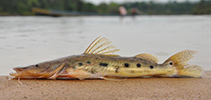Hemisorubim platyrhynchos (Valenciennes, 1840)
Porthole shovelnose catfish
Upload your photos and videos
Pictures | Google imageHemisorubim platyrhynchos
Picture by Sabaj Pérez, M.H.
Pictures | Google imageHemisorubim platyrhynchos
Picture by Sabaj Pérez, M.H.
Brazil country information
Common names:
Bico de pato, Boca de colher, Braço de moça
Occurrence: native
Salinity: freshwater
Abundance: | Ref:
Importance: minor commercial | Ref: Ferreira, E.J.G., J. Zuanon and G.M. dos Santos, 1996
Aquaculture: | Ref:
Regulations: | Ref:
Uses: live export: yes;
Comments: Recorded from the Caracu and Sao Pedro streams, both tributaries of the Paraná river (Ref. 26076). Found in fish markets in Santarém (Ref. 12202). Also Ref. 36506.
National Checklist:
Country Information: https://www.cia.gov/library/publications/resources/the-world-factbook/geos/br.html
National Fisheries Authority:
Occurrences: Occurrences Point map
Main Ref: Burgess, W.E., 1989
National Database:
Occurrence: native
Salinity: freshwater
Abundance: | Ref:
Importance: minor commercial | Ref: Ferreira, E.J.G., J. Zuanon and G.M. dos Santos, 1996
Aquaculture: | Ref:
Regulations: | Ref:
Uses: live export: yes;
Comments: Recorded from the Caracu and Sao Pedro streams, both tributaries of the Paraná river (Ref. 26076). Found in fish markets in Santarém (Ref. 12202). Also Ref. 36506.
National Checklist:
Country Information: https://www.cia.gov/library/publications/resources/the-world-factbook/geos/br.html
National Fisheries Authority:
Occurrences: Occurrences Point map
Main Ref: Burgess, W.E., 1989
National Database:
Common names from other countries
Classification / Names Nombres comunes | Sinónimos | Catalog of Fishes(Género, Especie) | ITIS | CoL | WoRMS | Cloffa
> Siluriformes (Catfishes) > Pimelodidae (Long-whiskered catfishes)
Etymology: Hemisorubim: Greek, hemi = half + Brazilian local name, sorubim (Ref. 45335).
More on author: Valenciennes.
Etymology: Hemisorubim: Greek, hemi = half + Brazilian local name, sorubim (Ref. 45335).
More on author: Valenciennes.
Environment: milieu / climate zone / depth range / distribution range Ecología
; agua dulce demersal; pH range: 6.0 - 7.8; dH range: ? - 25. Subtropical; 20°C - 22°C (Ref. 2060)
Distribución Países | Áreas FAO | Ecosistemas | Ocurrencias, apariciones | Point map | Introducciones | Faunafri
South America: Amazon, Maroni, Orinoco, and Paraná River basins.
Length at first maturity / Tamaño / Peso / Age
Maturity: Lm 31.6 range ? - ? cm
Max length : 61.0 cm TL (female); peso máximo publicado: 2.7 kg (Ref. 111728)
Max length : 61.0 cm TL (female); peso máximo publicado: 2.7 kg (Ref. 111728)
Rather rare, confined to the deeper and slow-moving parts of large rivers together with some Loricaria and Potamotrygon. Its body shape and color pattern are perfectly adapted to the muddy bottom where they stay (Ref. 35381). Feeds on benthic organisms and fish. The position of the eyes and the shape of the mouth of this piscivorous fish give to its stalking mode of hunting (Ref. 35381).
Life cycle and mating behavior Madurez | Reproducción | Puesta | Huevos | Fecundidad | Larva
Main reference
Upload your references | Referencias | Coordinador | Colaboradores
Lundberg, J.G. and M.W. Littmann, 2003. Pimelodidae (Long-whiskered catfishes). p. 432-446. In R.E. Reis, S.O. Kullander and C.J. Ferraris, Jr. (eds.) Checklist of the Freshwater Fishes of South and Central America. Porto Alegre: EDIPUCRS, Brasil. (Ref. 36506)
IUCN Red List Status (Ref. 130435: Version 2024-2)
Least Concern (LC) ; Date assessed: 16 December 2020
Threat to humans
Harmless
Human uses
Pesquerías: comercial; Acuario: Acuarios públicos
FAO(Publication : search) | FishSource |
Más información
Trophic ecology
componentes alimenticios
Composición de la dieta
consumo de alimento
Food rations
Despredadores
componentes alimenticios
Composición de la dieta
consumo de alimento
Food rations
Despredadores
Population dynamics
Coeficiente del crecimiento para
Max. ages / sizes
Length-weight rel.
Length-length rel.
Length-frequencies
Mass conversion
Reclutamiento
Abundancia
Coeficiente del crecimiento para
Max. ages / sizes
Length-weight rel.
Length-length rel.
Length-frequencies
Mass conversion
Reclutamiento
Abundancia
Life cycle
Reproducción
Madurez
Fecundidad
Puesta
Spawning aggregations
Huevos
Egg development
Larva
Dinámica larvaria
Reproducción
Madurez
Fecundidad
Puesta
Spawning aggregations
Huevos
Egg development
Larva
Dinámica larvaria
Anatomy
Superficie branquial
Brain
Otolith
Superficie branquial
Brain
Otolith
Physiology
Body composition
Nutrients
Consumo del oxígeno
Tipo de natación
Velocidad de natación
Visual pigments
Fish sound
Diseases & Parasites
Toxicity (LC50s)
Body composition
Nutrients
Consumo del oxígeno
Tipo de natación
Velocidad de natación
Visual pigments
Fish sound
Diseases & Parasites
Toxicity (LC50s)
Human related
Aquaculture systems
Perfiles de acuicultura
Razas
Ciguatera cases
Stamps, coins, misc.
Aquaculture systems
Perfiles de acuicultura
Razas
Ciguatera cases
Stamps, coins, misc.
Herramientas
E-book | Guía de campo | Asistente para frecuencias de tallas | Herramienta de ciclo de vida | Mapa de puntos | Classification Tree
| Catch-MSY |
Special reports
Download XML
Fuentes de Internet
Aquatic Commons | BHL | Cloffa | Websites from users | Check FishWatcher | CISTI | Catalog of Fishes(Género, Especie) | DiscoverLife | ECOTOX | Faunafri | Fishtrace | GenBank(genome, nucleotide) | GloBI | GOBASE | | Google Books | Google Scholar | Google | IGFA World Record | MitoFish | Bases de datos nacionales | Otolith Atlas of Taiwan Fishes | PubMed | Reef Life Survey | Scirus | SeaLifeBase | Árbol de la vida | Wikipedia(Go, búsqueda) | World Records Freshwater Fishing | Expediente Zoológico
Estimates based on models
Phylogenetic diversity index (Ref. 82804): PD50 = 1.0000 [Uniqueness, from 0.5 = low to 2.0 = high].
Bayesian length-weight: a=0.00708 (0.00603 - 0.00831), b=3.11 (3.06 - 3.16), in cm Total Length, based on LWR estimates for this species (Ref. 93245).
Nivel trófico (Ref. 69278): 4.5 ±0.80 se; based on food items.
Resiliencia (Ref. 120179): Medio, población duplicada en un tiempo mínimo de 1.4-4.4 años (Preliminary K or Fecundity.).
Fishing Vulnerability (Ref. 59153): Moderate to high vulnerability (45 of 100).




